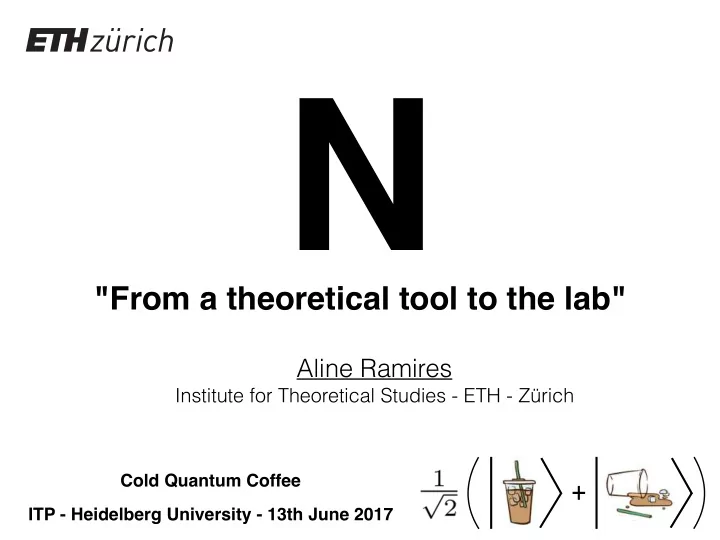

N "From a theoretical tool to the lab" Aline Ramires Institute for Theoretical Studies - ETH - Zürich Cold Quantum Coffee ITP - Heidelberg University - 13th June 2017
ETH - Hauptgebäude The Institute for Theoretical Studies 300m 5km - Established in 2013; ETH - ITP - Interdisciplinary institute dedicated to research in mathematics, theoretical physics and theoretical computer science; - Currently: 9 Junior Fellows and 6 Senior Fellows, - Support from Dr. Max Rössler and the Walter Haefner Foundation.
Outline Strongly Correlated Systems - Local Moment formation and the Kondo Effect Heavy Fermions Large-N approach - Spin and Time-reversal: Symplectic-N Decoupling spin Hamiltonians Q: Just a theoretical tool? - Enlarged symmetries with ultracold atoms
The Periodic Table of Elements
The Smith-Kmetko Diagram Magnetism Increasing localization 4f localization Increasing 5f 3d Fermi Liquid FS "Electrons in the brink of localization" More localized orbitals ⇒ Enhanced interactions ⇒ Strong Correlations J. L. Smith and E. A. Kmetko, J. of the Less-Common Metals (1982)
Examples of Strongly Correlated Systems Cuprates Fe-pnictides Heavy Fermions Ba(Fe 1-x Co x )As 2 Schematic diagram YBa 2 Cu 3 O x CeRhIn 5 Strange Strange Metal Metal Strange Strange T(K) T(K) metal metal x Fradkin, Nature Physics (2012) Tranquada, Physics 3 (2010) Knebel, J. Phys. Soc. Jpn. (2011) Electrons in the brink of localization ⇒ Easily tunable Repeating theme ⇒ What can we learn from HF?
Localized Orbital Effective models and local moment formation Anderson Impurity Model Conduction sea H Atomic Infinite-U Anderson Model U+ ε f Kondo Impurity Model - ε f>0 AFM At low T only the spin DOF remains. Requires: P. Coleman, Introd. to Many Body Physics (2015)
Poor-man scaling and the Kondo Effect Kondo Impurity Model E D States to be removed D - δ D What if we want to keep renormalizing? ρ (E) -D + δ D States to be removed -D J. Kondo, Prog. in Theor. Phys. 32, 1, 37 (1964) Below T K : Singlet Bound State P. W. Anderson, J. Phys. C: Solid State Phys. 3, 2436, 2 (1970)
Energy Scales in Heavy Fermions Kondo Lattice Model Doniach Phase Diagram Kondo Temperature Impurity: Lattice: Singlet Bound State HEAVY Fermi Liquid ? AFM FL RKKY Temperature QCP S. Doniach, Physica B (1977) J. Kondo, Prog. in Theor. Phys. 32, 1, 37 (1964) Ruderman-Kittel-Kasuya-Yosida (1954-57)
Take-home messages I & II: There is a class of materials called heavy fermion systems in which electrons are very strongly interacting. The effective models to describe them usually start from a Kondo lattice model, which is written in terms of local moments and cannot be treated perturbatively.
Large-N Approach No natural small energy scale: Introduce an artificial small parameter: 1/N Quantum Chromodynamics Barions (N-body singlets) Cooper Pairs Valence Bonds Condensed Matter ? L. Balents, Nature (2010) G. t’Hooft, Nucl Phys B 71, 461 (1973) E. Witten, Nucl Phys B 160, 57 (1979)
Motivation to keep time reversal Symplectic-N Approach Requirement of consistency Symplectic condition Time-reversal: Generators: Generalized Spin Operators Now we have a generalisation of spin operators which are well behaved under the time-reversal operation. R. Flint et. al., Nature (2008)
Decoupling Spin Hamiltonians SU(N) Symmetry SP(N) Symmetry Hopping / Hybridization Superconductivity / Valence Bonds SP(N) properly accounts for Frustration and Superconductivity!
Take-home messages III & IV: CeRhIn 5 Large-N generalisations are useful for the description of strongly correlated materials. The symplectic-N approach seems to provide a more Θ appropriate generalisation of spin operators
Q: Are these models with enlarged symmetries only theoretical tools or can they be real? I feel like a heavy fermion!
Cold Atoms and enlarged symmetries At ultra-low temperatures and in the low density limit, we can model interacting atoms with contact interactions. Total angular momentum conservation. f: Hyperfine Spin (Total angular momentum of the atom) F: Total angular momentum of the PAIR of atoms which is scattering
Cold Atoms and enlarged symmetries Note that only even-F channels contribute to scattering: Taking α <-> β and using properties of the CGC: We find: So for both Bosons ( η = 1 and 2f even) and Fermions ( η = -1 and 2f odd): F = 0 , 2 , 4 , 6 , …
Cold Atoms and enlarged symmetries SU(N) Symmetry SP(N) Symmetry Condition: Realization: Alkaline-Earth atoms *Naturally satisfied for Define: in this case the interaction vertex simplifies to: Number of particles in each flavour = n α , “Colour magnetization” = n α -n - α is a conserved quantity. is a conserved quantity. A. Ramires arXiv 1606.08709 (2017)
Cold Atoms and enlarged symmetries 1) Not strong dipole-dipole interaction 2) Stable Elements 3) Fermionic Isotopes with f > 1/2 SP(8) SP(6) Dipolar character SP(10) Already Condensed Realizes SP(N) * Realizes SU(N) T. Maier, PhD Thesis (2015)
Take-home messages V & VI: It is possible to realise systems with enlarged symmetries in cold atomic systems SP(N) is a current challenge for experimentalists.
Conclusion - Motivated by heavy fermion systems - Looked for appropriate theoretical tools: Symplectic-N - Q: Are these models with enlarged symmetries real? - Cold atoms can realise SU(N) and SP(N) symmetries I feel like a heavy fermion!
Recommend
More recommend